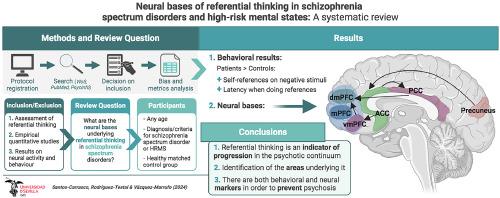精神分裂症谱系障碍和高危精神状态中参照思维的神经基础:系统回顾
IF 2.5
4区 医学
Q2 PSYCHIATRY
引用次数: 0
摘要
背景和目的如今,精神分裂症研究正朝着寻找疾病早期征兆的方向发展。科学文献中强调的精神病进展标志之一是参照思维。因此,这项工作的主要目的是分析评估参照思维的主要形式,以及高危精神状态和精神谱系障碍患者这一过程的神经基础。方法在三个电子数据库(Web of Science、PsycInfo 和 PubMed)中进行了系统检索。检索了采用病例对照设计的实验研究,然后通过纽卡斯尔-渥太华量表对这些研究进行了文献分析和潜在的偏倚风险分析。结果 在 200 项可能相关的研究中,有 28 项符合纳入标准。结果显示,最常见的评估方式是对人格短语和特质进行自我反思的实验任务。在所审查的研究中,与对照组相比,患者的负面自我暗示更多,反应潜伏期更长。在神经基础方面,患者在背内侧和腹外侧前额叶皮质、前扣带回皮质和后扣带回皮质或楔前皮质等区域表现出更多与参照思维相关的神经活动。这种前-后枢纽可能是神经精神疾病中参照思维缺陷的基础。本文章由计算机程序翻译,如有差异,请以英文原文为准。

Neural bases of referential thinking in schizophrenia spectrum disorders and high-risk mental states: A systematic review
Background and objectives
Nowadays, schizophrenia research is moving towards the search for early signs of illness. One of the psychosis progression markers highlighted in scientific literature is referential thinking. Thus, the main objective of this work is to analyze the main forms of assessment of referential thinking, as well as the neural bases underlying this process in people with high-risk mental states and psychotic spectrum disorders.
Methods
A systematic search was carried out in three electronic databases (Web of Science, PsycInfo, and PubMed). Experimental studies with case-control designs were searched, and then analyzed both bibliographically and based on their potential risk of bias through the Newcastle-Ottawa scale. The protocol was registered in PROSPERO [CRD42021291691].
Results
Of the 200 potentially relevant studies, 28 met the inclusion criteria. The results showed that the most common way of assessment was the experimental task of making self-reflection about personality phrases and traits. In the studies reviewed, there was a greater number of negative self-references and a greater response latency among the patients when compared to controls. Regarding neural bases, patients showed more neural activity associated with referential thinking in areas such as the dorsomedial and ventromedial prefrontal cortices, the anterior and posterior cingulate cortices, or the precuneus.
Conclusions
The results confirm the hypothesis of referential thinking as an indicator of progression in the psychotic continuum, while highlighting a set of areas that could be hyperactivated in a network of postero-anterior functional connectivity. This antero-posterior hub could underlie the referential thinking deficit in neuropsychiatric disorders.
求助全文
通过发布文献求助,成功后即可免费获取论文全文。
去求助
来源期刊

European Journal of Psychiatry
PSYCHIATRY-
CiteScore
2.90
自引率
0.00%
发文量
40
审稿时长
43 days
期刊介绍:
The European journal of psychiatry is a quarterly publication founded in 1986 and directed by Professor Seva until his death in 2004. It was originally intended to report “the scientific activity of European psychiatrists” and “to bring about a greater degree of communication” among them. However, “since scientific knowledge has no geographical or cultural boundaries, is open to contributions from all over the world”. These principles are maintained in the new stage of the journal, now expanded with the help of an American editor.
 求助内容:
求助内容: 应助结果提醒方式:
应助结果提醒方式:


